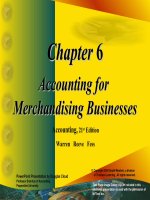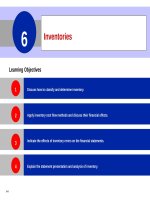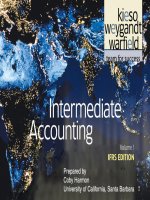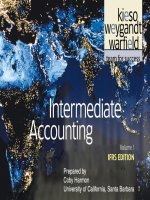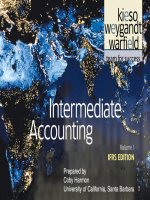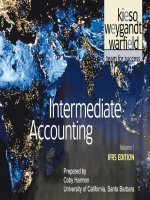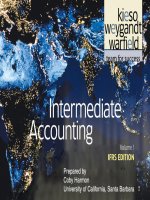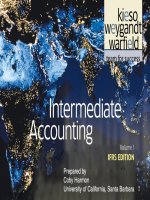Intermediate accounting volum 1 IFRS edition chapter 06
Bạn đang xem bản rút gọn của tài liệu. Xem và tải ngay bản đầy đủ của tài liệu tại đây (1.57 MB, 83 trang )
6-1
CHAPTER
6
ACCOUNTING AND THE
TIME VALUE OF MONEY
Intermediate Accounting
IFRS Edition
Kieso, Weygandt, and Warfield
6-2
Learning
Learning Objectives
Objectives
6-3
1.
Identify accounting topics where the time value of money is relevant.
2.
Distinguish between simple and compound interest.
3.
Use appropriate compound interest tables.
4.
Identify variables fundamental to solving interest problems.
5.
Solve future and present value of 1 problems.
6.
Solve future value of ordinary and annuity due problems.
7.
Solve present value of ordinary and annuity due problems.
8.
Solve present value problems related to deferred annuities and
bonds.
9.
Apply expected cash flows to present value measurement.
Accounting
Accounting and
and the
the Time
Time Value
Value of
of Money
Money
Basic Time
Value
Concepts
Applications
The nature of
interest
Simple interest
Compound
interest
Fundamental
variables
6-4
Single-Sum
Problems
Future value
of a single
sum
Present value
of a single
sum
Solving for
other
unknowns
Annuities
Future value of
ordinary
annuity
Future value of
annuity due
Examples of
FV of annuity
Present value
of ordinary
annuity
Present value
of annuity due
Examples of
PV of annuity
More
Complex
Situations
Deferred
annuities
Valuation of
long-term
bonds
Effectiveinterest
method of
bond discount/
premium
amortization
Present Value
Measurement
Choosing an
appropriate
interest rate
Example of
expected cash
flow
Basic
Basic Time
Time Value
Value Concepts
Concepts
Time Value of Money
A relationship between time and money.
A dollar received today is worth more than a dollar
promised at some time in the future.
6-5
LO 1 Identify accounting topics where the time value of money is relevant.
Basic
Basic Time
Time Value
Value Concepts
Concepts
Applications to Accounting Topics:
1. Notes
2. Leases
3. Pensions and Other
Postretirement
Benefits
5. Shared-Based
Compensation
6. Business Combinations
7. Disclosures
8. Environmental Liabilities
4. Long-Term Assets
6-6
LO 1 Identify accounting topics where the time value of money is relevant.
Basic
Basic Time
Time Value
Value Concepts
Concepts
The Nature of Interest
Payment for the use of money.
Excess cash received or repaid over the amount
borrowed (principal).
6-7
LO 1 Identify accounting topics where the time value of money is relevant.
Basic
Basic Time
Time Value
Value Concepts
Concepts
Simple Interest
Interest computed on the principal only.
Illustration: KC borrows $20,000 for 3 years at a rate of 7%
per year. Compute the total interest to be paid for the 3 years.
Total
Interest
Interest = p x i x n
= $20,000 x .07 x 3
= $4,200
Many regulatory frameworks require disclosure of interest rates on an annual basis.
6-8
LO 2 Distinguish between simple and compound interest.
Basic
Basic Time
Time Value
Value Concepts
Concepts
Simple Interest
Interest computed on the principal only.
Illustration: KC borrows $20,000 for 3 years at a rate of 7%
per year. Compute the total interest to be paid for the 1 year.
Annual
Interest
Interest = p x i x n
= $20,000 x .07 x 1
= $1,400
6-9
LO 2 Distinguish between simple and compound interest.
Basic
Basic Time
Time Value
Value Concepts
Concepts
Simple Interest
Interest computed on the principal only.
Illustration: On March 31, 2011, KC borrows $20,000 for 3
years at a rate of 7% per year. Compute the total interest to be
paid for the year ended Dec. 31, 2011.
Partial
Year
Interest = p x i x n
= $20,000 x .07 x 9/12
= $1,050
6-10
LO 2 Distinguish between simple and compound interest.
Basic
Basic Time
Time Value
Value Concepts
Concepts
Compound Interest
Computes interest on
principal and
interest earned that has not been paid or
withdrawn.
Most business situations use compound interest.
6-11
LO 2 Distinguish between simple and compound interest.
Basic
Basic Time
Time Value
Value Concepts
Concepts
Illustration: Tomalczyk Company deposits $10,000 in the Last National
Bank, where it will earn simple interest of 9% per year. It deposits another
$10,000 in the First State Bank, where it will earn compound interest of
9% per year compounded annually. In both cases, Tomalczyk will not
withdraw any interest until 3 years from the date of deposit.
Illustration 6-1
Simple vs. Compound Interest
Year 1 $10,000.00 x 9%
$ 900.00
$ 10,900.00
Year 2 $10,900.00 x 9%
$ 981.00
$ 11,881.00
Year 3 $11,881.00 x 9%
6-12
$1,069.29 $ 12,950.29
LO 2 Distinguish between simple and compound interest.
Basic
Basic Time
Time Value
Value Concepts
Concepts
Compound Interest Tables
Table 1 - Future Value of 1
Table 2 - Present Value of 1
Table 3 - Future Value of an Ordinary Annuity of 1
Table 4 - Present Value of an Ordinary Annuity of 1
Table 5 - Present Value of an Annuity Due of 1
Number of Periods = number of years x the number of
compounding periods per year.
Compounding Period Interest Rate = annual rate divided by the
number of compounding periods per year.
6-13
LO 3 Use appropriate compound interest tables.
Basic
Basic Time
Time Value
Value Concepts
Concepts
Compound Interest
Illustration 6-2
Excerpt from Table 6-1
How much principal plus interest a dollar accumulates to at the end of
each of five periods, at three different rates of compound interest.
6-14
LO 3 Use appropriate compound interest tables.
Basic
Basic Time
Time Value
Value Concepts
Concepts
Compound Interest
Formula to determine the future value factor (FVF) for 1:
Where:
FVF n,i
6-15
= future value factor for n periods at i interest
n
= number of periods
i
= rate of interest for a single period
LO 3 Use appropriate compound interest tables.
Basic
Basic Time
Time Value
Value Concepts
Concepts
Compound Interest
Determine the number of periods by multiplying the number
of years involved by the number of compounding periods
per year.
Illustration 6-4
Frequency of Compounding
6-16
LO 3 Use appropriate compound interest tables.
Basic
Basic Time
Time Value
Value Concepts
Concepts
Compound Interest
9% annual interest compounded daily provides a 9.42%
yield.
Effective Yield for a $10,000 investment.
6-17
Illustration 6-5
Comparison of Different
Compounding Periods
LO 3 Use appropriate compound interest tables.
Basic
Basic Time
Time Value
Value Concepts
Concepts
Fundamental Variables
Rate of Interest
Number of Time Periods
Future Value
Present Value
6-18
Illustration 6-6
LO 4 Identify variables fundamental to solving interest problems.
Single-Sum
Single-Sum Problems
Problems
Two Categories
Unknown Present Value
Unknown Future Value
Illustration 6-6
6-19
LO 5 Solve future and present value of 1 problems.
Single-Sum
Single-Sum Problems
Problems
Future Value of a Single Sum
Value at a future date of a given amount invested, assuming
compound interest.
Where:
FV = future value
PV = present value (principal or single sum)
FVF n,i = future value factor for n periods at i interest
6-20
LO 5 Solve future and present value of 1 problems.
Future
Future Value
Value of
of aa Single
Single Sum
Sum
Illustration: Bruegger Co. wants to determine the future
value of $50,000 invested for 5 years compounded annually at
an interest rate of 11%.
= $84,253
Illustration 6-7
6-21
LO 5 Solve future and present value of 1 problems.
Future
Future Value
Value of
of aa Single
Single Sum
Sum
Alternate
Calculation
Illustration: Bruegger Co. wants to determine the future
value of $50,000 invested for 5 years compounded annually at
an interest rate of 11%.
What table
do we use?
Illustration 6-7
6-22
LO 5 Solve future and present value of 1 problems.
Alternate
Calculation
Future
Future Value
Value of
of aa Single
Single Sum
Sum
i=11%
n=5
What factor do we use?
$50,000
Present Value
6-23
x
1.68506
Factor
=
$84,253
Future Value
LO 5 Solve future and present value of 1 problems.
Future
Future Value
Value of
of aa Single
Single Sum
Sum
BE6-1: Bob Anderson invested $15,000 today in a fund that
earns 8% compounded annually. To what amount will the
investment grow in 3 years?
Present Value
$15,000
0
1
Future Value?
2
3
4
5
6
What table do we use?
6-24
LO 5 Solve future and present value of 1 problems.
Future
Future Value
Value of
of aa Single
Single Sum
Sum
i=8%
n=3
$15,000
Present Value
6-25
x
1.25971
Factor
=
$18,896
Future Value
LO 5 Solve future and present value of 1 problems.


